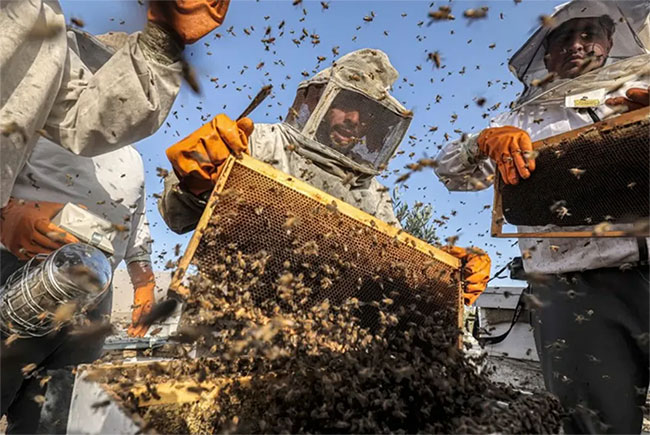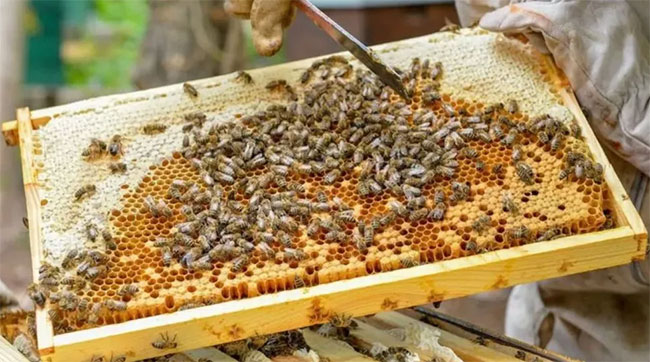Could the honey bee population in the world be wiped out because of a dangerous virus?
Professor Dr. Robert Paxton from Martin Luther University Halle Wittenberg (MLU) in the city of Halle, Lower Saxony, Germany, warned that the latest variant of the Deformed Wing virus could wipe out honey bee populations worldwide.

The Deformed Wing virus is the biggest threat to honey bees today.
Paxton heads the Department of General Zoology at MLU. The renowned expert on honey bees and wild bee diseases warns: "The Deformed Wing virus is the biggest threat to honey bees today. Our laboratory research has shown that the new variant is very easy to find. spread and are killing bees faster'.
An international team of researchers has analyzed virus variants over the past 20 years and found that this virus variant can severely damage an insect's wings before it kills them.
The new variant of the virus is spread by the varroa tick and is one of the biggest threats to honey bees in the world. These mites enter the hive and reproduce by laying eggs in the pupae.
The latest MLU research has revealed the new variant has replaced the old one in Europe and is rapidly spreading to other regions. Scientists at the MLU examined 3,000 different data sets to identify regions affected by the new variation.
"Our analysis confirms that the new variant has become the leading variant in Europe. We fear this variant will soon spread worldwide and it is only a matter of time," explains Paxton.
The new variant called DVW-B was first discovered in Europe and Africa in the early years of this millennium. It started spreading in North and South America in 2010. In 2015, DVW-B arrived in Asia.

Bees are the most important creatures for humans and the environment.
Paxton said the new variant has appeared on all continents except Australia. The zoologist explained that the inability of the varroa mite to reproduce on its own to a larger extent could be the reason.
The scientist added: 'Basic general hive hygiene measures are paramount to beekeepers when it comes to protecting bee colonies from varroa mites. He emphasized: 'Bees are the most important organism for humans and the environment'.
Prior to joining MLU, Paxton was assigned as a lecturer and reader in Insect Ecology at Queen's University in Belfast, Northern Ireland, from 2003 to 2010. Prior to that, he also did research. at scientific institutions in Wales, Sweden and Mexico.
Honey bees are insects with a herd lifestyle and high social organization. They are responsible for pollinating flowers and producing honey that humans use every day.
Only eight extant honey bee species are currently recognized and a total of 43 subspecies. However, honey bees make up only a small fraction of the approximately 20,000 known bee species.
The best known honey bee is the western honey bee (Apis mellifera), which has been domesticated to produce honey and pollinate crops. The only other domesticated bee species is the eastern honey bee (Apis cerana), which occurs in South Asia.
- More and more viruses are dying around the world, and the reason is not pleasant at all
- Check out the most dangerous viruses on the planet
- How effective is it to use honey?
- The special type of honey can cure the same ulcers as antibiotics
- Looking back at the past, present and future world population
- Why are more and more new viruses threatening humans?
- Two-thirds of the world's population is infected with sexually transmitted viruses
- How is honey formed?
- Crazy honey creates excitement like marijuana
- 5 best times to drink honey
- Half the world's population lives on 1% of the Earth
- 75% of honey is sampled in the world infected with pesticides
 Why do potatoes have eyes?
Why do potatoes have eyes? 'Tragedy' the world's largest carnivorous life: Death becomes ... public toilet
'Tragedy' the world's largest carnivorous life: Death becomes ... public toilet Tomatoes were once considered 'poisonous' for 200 years
Tomatoes were once considered 'poisonous' for 200 years Detecting microscopic parasites on human face
Detecting microscopic parasites on human face